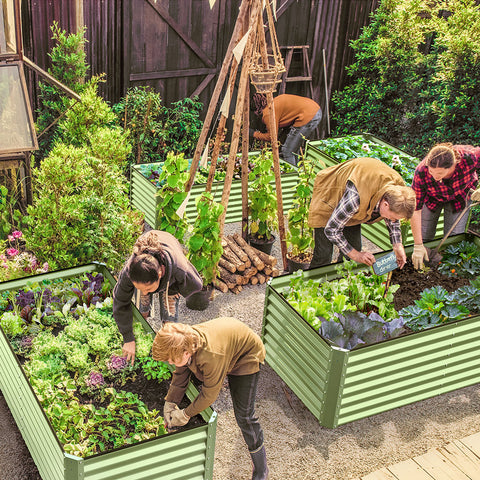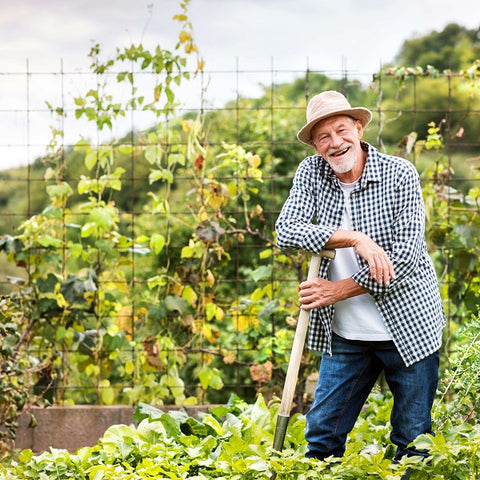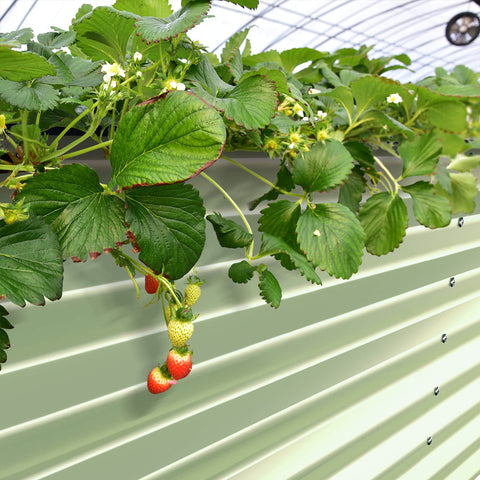For newcomers, home gardening can be daunting because scientific terms are as thick as summer weeds. There's no escaping the complexities of navigating naturally grown food, but they become more intuitive with practice. While waiting for intuition, it can be helpful to start with a clearly structured plan. The following content also has some reference value for raised garden beds.
Many gardening techniques tout simplicity, reduced waste, easier work and abundant harvests. Square foot gardening is one such approach, with an impressive track record of adoption. The network-format raised bed system has inspired thousands of new gardeners to try their hand at growing food. SFG was popularized by retired engineer-turned-amateur gardener Mel Bartholomew, who published his first book, Square Foot Gardening, in 1981. He starred in the PBS and Discovery Channel TV series of the same name.
Read on to learn the philosophy behind this beginner-friendly approach, the pros and cons of some practices, how to start a square foot garden, and suggestions for other ways to explore. Whether you've gathered a few tips or implemented them in full swing, SFG is an inspiring, pragmatic body of resources that can help you enjoy amazing richness from your little corner (or square) of the Earth.

What is square foot gardening?
SFG is an easy to digest, easy to learn method of home gardening designed to simplify and reduce waste, promising greater efficiency, easier work and greater productivity. The technique could help gardeners learn a denser way to grow plants, using wooden raised beds that are divided into 1'x1 'squares by a covered wooden grid. It compartmentalizes the planting process and helps gardeners maximize space by working inch by inch, square by square. As the seasons change, each square is planted with different vegetables, fruits, herbs or flowers.
By planting a variety of plants in one bed, gardeners reap a larger, more varied harvest while weeding and watering less frequently (compared to traditional row gardening). Bartholomew's recommended soil mixture is designed to provide natural nutrients and eliminate synthetic inputs.
A now international phenomenon, SFG is also known as square gardening. The Square Foot Gardening Foundation estimates that compared to single-row gardening, this method "costs 50 percent less, occupies 20 percent less space, uses 10 percent less water, and does only 2 percent less work."
It's important to consider the metrics behind these success claims. The resourcefulness and richness of SFG compared to traditional row gardening, which may have been the norm in the 70's, 80's and 90's, but not necessarily the norm in backyard gardening today. Today, we have the resources to grow high-bed gardening in small Spaces with no chemical inputs, prioritizing sustainability and efficiency.
So it's worth asking whether SFG is still a uniquely effective technique when compared to other organic bed gardening methods? Where does it shine and where does it fall short?
The advantages of square feet of gardening
If you are new to the garden game, this method is a good place to start. SFG is like riding a bike with training wheels - it provides a reassuring sense of boundaries and confidence. When broken down into uniform squares, the task of planning, planting, harvesting and tending the garden becomes more manageable.

Just as there are many ways for people to learn in school, there are endless ways to practice gardening. Which techniques resonate best with your learning style and aesthetic - there is no one right way. For those who think and learn in a linear, systems-oriented way, SFG may be appealing. It's a way to approach the unknown of nature with a clear plan of action and an orderly set of checkboxes.
SFG Resources is an advocate for chemical-free gardening, offering alternatives to using products that harm pollinators, water supplies, and health. The SFG approach has undoubtedly made an impact by steering home gardeners away from the unnecessary and unwitting application of synthetic fertilizers, pesticides and herbicides.
Disadvantages of square foot gardening
While certain learning styles and aesthetics tend toward the neat boxes of SFG, others may find gridded high beds creatively limiting or unsightly. Especially for art gardeners who like to follow natural forms, the perfect square can feel a little counterintuitive.
Grid planting may save space, but it does not automatically equate to abundant gardening. SFG does not address concepts like intercropping and companion planting, which emphasize plant partnerships that have proven to be beneficial (or antagonistic).
While it's good advice to make the most of every square inch, gardening in close quarters is about knowing which plants work best together in harmony. Sustainable development can be enhanced by including companion planting (focusing on symbiotic plant partnerships) and intercropping (developing plant mix strategies based on harvest time, root depth and resource use).
The technology also claims that a depth of 6 inches is sufficient for all crops, but such shallow planting may not provide enough room for root development or drainage. In urban gardens, deeper raised beds create a buffer between food crops and potential heavy metal contamination in the native soil. A high bed depth of 12-18 inches is ideal, but 6 inches is sufficient for leafy greens, shallow-rooted plants, and herbs.
While the recommended SFG mixture of peat, compost, and vermiculite is a useful recipe, the quality of compost varies greatly. Only by testing the compost can you be sure that the essential nutrients are adequate and balanced. High nitrogen content in compost is a common problem. This results in over-abundant leaf growth with bland flowering, root development and fruiting sets. To enhance microbial activity or fill gaps in essential nutrients, an organic slow-release modifier may be needed. Depending on the quality of compost available, purchasing a bagged organic bed raising mixture may yield better results. Ask around in your community to find quality ingredients.
How to start a square foot garden
With these criticisms in mind, SFG remains a valuable way to plan, plant, and enjoy a home garden. This is especially true if you're a beginner gardener or a linear thinker who likes a methodical process. After all, Mayer, the creator of this approach, is an engineer.

The grid system allows for efficient use of space and helps gardeners make the most of the season. Once a square is cleared of crops, it is cleared and replanted.
While eggplant requires a whole field to grow, smaller crops like radishes and arugula can be planted densely in one field. Please refer to SFG's helpful chart for spacing and seasonal rotation tips.
The eight steps to setting up a garden:
- Plan your garden by drawing a grid: Use grid paper to draw your garden bed to scale. The ideal bed size is 3-4 feet wide and 4-8 feet long. Through your sketch, note how many squares you need to fill and insert a plant (or plants) into each 1-foot square. Research the idea of pairing wise plants grown by peers and discover universally beneficial plants such as nasturtiums and marigolds.
- Paint the bigger picture: Draw an aerial view of your yard. Consider sun exposure, water source location and proximity to the kitchen for easy harvesting.
- Build your box and grid: Use durable, untreated wood, such as cedar, to build your garden bed and the square foot grid above. Make sure the ground beneath them is level so that the water flows out evenly.
- Build accessories like trellises: Growing plants requires additional trellises for support, which can easily be built with T-posts and cattle board wire or trellises mesh. Vertical planting further maximizes the garden space and frees up more square space.
- Create your soil mix: A special recipe (called "Meir Mix") of peat moss, compost, and vermiculite is recommended for SFG beds. With a natural nutrient-rich mixture, fertilizer is not necessary.
- Plant your garden: Once the bed has been built and filled with soil, it's time to plant. Follow the spacing recommendations on the seed package and plant seeds that are delicious, beautiful or good for the ecosystem on every square foot. Even if the soil is already moist, water it after the transplant to help the roots take hold.
- Maintain your garden: Incorporate the garden into your daily routine so that you can water, prune, weed, and harvest at all times. That way, you can spot problems before they become problems. With the SFG method, weeds are usually minimal.
- Harvest and enjoyment: There is nothing more satisfying than enjoying your own produce. Enjoy the experience and try to grow something new each season.
Square foot gardening in the background
Since the founding of SFG, collective gardening knowledge has expanded greatly. When Bartholomew began documenting his approach in the '70s and' 80s, it was a bold alternative to the kind of gardening that many Americans at the time were teaching and practicing in their backyards - essentially a scaled-down version of the industrial tradition of line farming. This approach multiplies pests and weeds, requires large amounts of water and fertilizer, and leads to overbreeding of certain crops and an overall lack of biodiversity. Observing these shortcomings through his community garden club, SFG was Bartholomew's resourceful and hopeful solution.
While SFG is a forward-thinking choice for the current state of its environment, its teachings are not entirely original, and our understanding of garden ecology has grown accordingly. From a cultural and historical point of view, intensive and organic gardening in small Spaces is nothing new. With the Industrial Revolution in the West, there was a shift from this more intensive type of farming to a linear, input-heavy type.
A variety of methods for bed gardening
Looking ahead to and after SFG, the treasure trove of horticultural knowledge drawn from cross-cultural generations of small-scale farming and current scientific research is worth exploring. Explore the countless books and articles on companion farming, no-till (also known as no-till) gardening, kitchen gardening, organic market gardening, permaculture, and biointensive farming for approaches with similar goals and deep expertise. You may find that SFG, while useful and influential, has only scratched the surface of your small garden dream.

Think outside the box
SFG's photos often show grid beds in the middle of empty lawns, ignoring the important space beyond the box. It helps us to see the garden as a whole ecosystem. While raised beds are an excellent tool for growing healthy food with better control over soil quality, they can be a buffet for wildlife when no other feed is available. When space allows, create habitat and food sources for wildlife outside of your bed - through pollinators, fruit trees and shrubs, bush piles, bird feeders, leaf mulch, and more. That way, pests won't despair of your lettuce, and you'll enjoy a bigger bounty thanks to the biodiversity and abundance of pollinators.
When you learn a skill like gardening, find what works for you and trust yourself to try it. Once you learn the rules, you can break them if you find a solution that more fully serves your garden, your home, your culture, and the ecosystem you're in.









